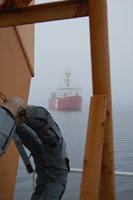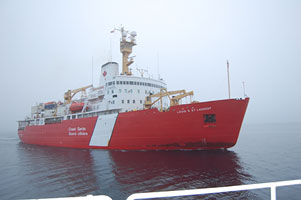

 | |||||||||||||||
|
|
Journals 2009/2010Jonathan Pazol
August 11, 2009 We finally met up with the Canadian icebreaker Louis S. St-Laurent (the Louis - pronounced 'Louie' in the French style, of course) in the afternoon. Announcements starting coming over the PA system and the crew prepared for a helicopter transfer of personnel from one ship to the other, including the Canadian chief scientist and captain. We also sent an Information Technology person over to set up a network between the ships and exchanged ice observers - scientists whose job is to look and classify the amount and types of ice in the area. Once the exchanges were complete, the Louis set up to start its seismic tests, and we prepared to do an acoustic test, in order to monitor and calibrate the sound the equipment made. Ethan Roth, from Scripps, put together two hydrophones that each measured sound at different frequencies. With some of the MST (Marine Science Technician) crew members, he strapped them together and lowered them into the water.
The hydrophones work by picking up sounds underwater. As the Louis did the seismic tests, Ethan recorded the sound field (all the sounds in the environment). Acoustic testing is done for several reasons. One is to quantify the noise levels that a sound source makes, so that the actual data being collected is calibrated correctly. The other reason is to be able to provide data on anthropogenic (human made) noise. This is done to comply with noise standards set by the National Marine Fisheries Service on how noise affects marine mammals and fish. Ethan will now analyze this data and report it back to the US Geological Survey. In the meantime, the Louis was engaged in seismic testing. This involves the Healy remaining stationary and the Louis circling the Healy in a figure-eight formation several times while running the tests. It was a very surreal experience to see a huge ship coming directly toward us in the fog. It passed within about 100 meters, which when you're on the ocean looks a whole lot closer. The other amazing thing was that the ship had almost no wake. The ocean was as smooth as glass, and it hardly left a ripple.
Seismic testing involves the sending out of seismic waves that will penetrate down into the sea floor sediment. The Healy has a Knudsen system that "chirps" periodically as it sends out waves to the bottom and reach about 75 meters into the sea floor. From my stateroom, I can actually hear the sound, and it does sound like a bird's chirp. For this expedition, the Louis is using a different system. It uses a set of four air guns that work in sync to shoot down a pulse every 20 seconds. This wave can penetrate far deeper than the Knudsen - about 750 meters into the sediment and will provide vital information for the mapping. Now that we're heading further north, we are encountering more and more ice. The ship has a set of video cameras that provides a live display from different locations on the ship. The camera on the Aloft Conn - the tower at the bow, also records and uploads images every hour. If someone ever wants to see the view from the Aloft Conn while the Healy is on a cruise, a link at http://mgds.1deo.columbia.edu/healy/reports/aloftcon/2009/ provides these images. |
||||||||||||||


